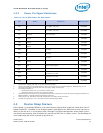
Intel® Solid-State Drive 530 Series (2.5-inch)
October 2013 Product Specification
Order Number: 329212-003US 5
1 Introduction
This document describes the specifications and capabilities of the Intel® Solid-State Drive 530 Series
(Intel® SSD 530 Series).
The Intel SSD 530 Series delivers the next generation storage solution with new low power features
designed for Ultrabook™. The next generation Intel SSD continues to provide high performance
expected for Serial Advanced Technology Attachment (SATA)-based computers.
The industry-standard 2.5-inch form factor enables interchangeability with existing hard disk drives
(HDDs) and native SATA HDD drop-in replacement with the enhanced performance, reliability, and
ruggedness offered by an SSD.
The latest feature addition is the DevSleep functionality, a low power drive state controlled by the host
via the DevSleep pin. The drive will consume a mere 5 mW while in this state.
As compared to standard SATA HDDs, Intel SSD 530 Series offers these key features:
• High I/O and throughput performance
• Low power consumption
• Increased system responsiveness
• High reliability
• Enhanced ruggedness
The Intel SSD 530 Series also offers additional key features such as:
• Advanced Encryption Standard (AES) 256-bit Encryption
AES 256-bit encryption is an industry standard in data security, providing a hardware-based
mechanism for encryption and decryption of user data. Utilizing a 256-bit encryption key, AES
encryption—when combined with an ATA drive password—helps protect user data.
• End-to-End Data Protection
End-to-end data protection helps protect data from being corrupted across the data path by using
cyclic redundancy check (CRC), parity, and error correction code (ECC) checks in the data path from
the host interface to the NAND, and back.
• Data Compression
Data compression helps improve performance and endurance by automatically compressing
information sent to the SSD so that less data has to be processed and stored on the NAND. The
amount of data that can be compressed depends on the type of data.


















